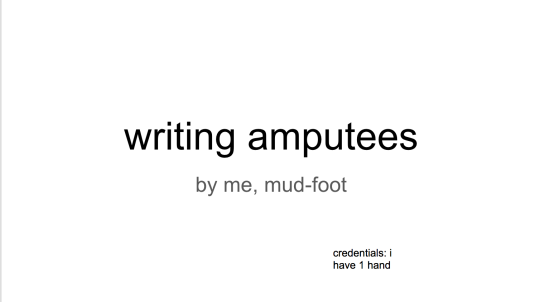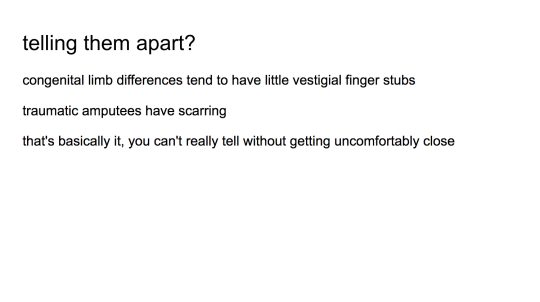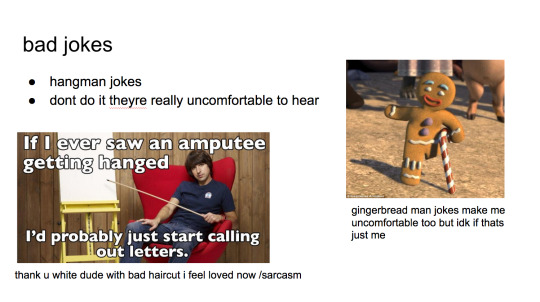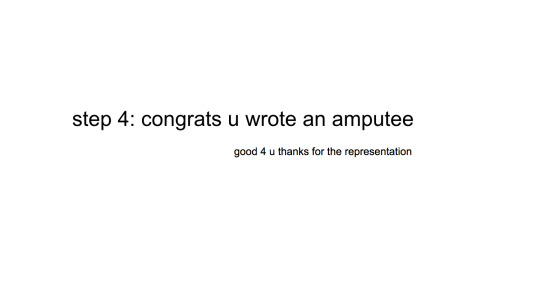Text
Okay, so I changed a few words in the scene and it suddenly went from "meh" to "wow, this is actually kinda breaking my heart".
2 notes
·
View notes
Text
IT’S NOT ‘PEEKED’ MY INTEREST
OR ‘PEAKED’
BUT PIQUED
‘PIQUED MY INTEREST’
THIS HAS BEEN A CAPSLOCK PSA
686K notes
·
View notes
Text
Reblog if you have an original story!
I’m not talking about fanfictions or AU’s based off of a video game/comic/TV series, I’m talking about a story with a world and characters that are YOURS and YOURS alone.
68K notes
·
View notes
Text
Ways to un-stick a stuck story
Do an outline, whatever way works best. Get yourself out of the word soup and know where the story is headed.
Conflicts and obstacles. Hurt the protagonist, put things in their way, this keeps the story interesting. An easy journey makes the story boring and boring is hard to write.
Change the POV. Sometimes all it takes to untangle a knotted story is to look at it through different eyes, be it through the sidekick, the antagonist, a minor character, whatever.
Know the characters. You can’t write a story if the characters are strangers to you. Know their likes, dislikes, fears, and most importantly, their motivation. This makes the path clearer.
Fill in holes. Writing doesn’t have to be linear; you can always go back and fill in plotholes, and add content and context.
Have flashbacks, hallucinations, dream sequences or foreshadowing events. These stir the story up, deviations from the expected course add a feeling of urgency and uncertainty to the narrative.
Introduce a new mystery. If there’s something that just doesn’t add up, a big question mark, the story becomes more compelling. Beware: this can also cause you to sink further into the mire.
Take something from your protagonist. A weapon, asset, ally or loved one. Force him to operate without it, it can reinvigorate a stale story.
Twists and betrayal. Maybe someone isn’t who they say they are or the protagonist is betrayed by someone he thought he could trust. This can shake the story up and get it rolling again.
Secrets. If someone has a deep, dark secret that they’re forced to lie about, it’s a good way to stir up some fresh conflict. New lies to cover up the old ones, the secret being revealed, and all the resulting chaos.
Kill someone. Make a character death that is productive to the plot, but not “just because”. If done well, it affects all the characters, stirs up the story and gets it moving.
Ill-advised character actions. Tension is created when a character we love does something we hate. Identify the thing the readers don’t want to happen, then engineer it so it happens worse than they imagined.
Create cliff-hangers. Keep the readers’ attention by putting the characters into new problems and make them wait for you to write your way out of it. This challenge can really bring out your creativity.
Raise the stakes. Make the consequences of failure worse, make the journey harder. Suddenly the protagonist’s goal is more than he expected, or he has to make an important choice.
Make the hero active. You can’t always wait for external influences on the characters, sometimes you have to make the hero take actions himself. Not necessarily to be successful, but active and complicit in the narrative.
Different threat levels. Make the conflicts on a physical level (“I’m about to be killed by a demon”), an emotional level (“But that demon was my true love”) and a philosophical level (“If I’m forced to kill my true love before they kill me, how can love ever succeed in the face of evil?”).
Figure out an ending. If you know where the story is going to end, it helps get the ball rolling towards that end, even if it’s not the same ending that you actually end up writing.
What if? What if the hero kills the antagonist now, gets captured, or goes insane? When you write down different questions like these, the answer to how to continue the story will present itself.
Start fresh or skip ahead. Delete the last five thousand words and try again. It’s terrifying at first, but frees you up for a fresh start to find a proper path. Or you can skip the part that’s putting you on edge – forget about that fidgety crap, you can do it later – and write the next scene. Whatever was in-between will come with time.
135K notes
·
View notes
Text
BEHOLD
THE END OF THE WHUMPER’S WRITER’S BLOCK
ambien Taylor has made a chart that you can fill out with all your fav characters, scenarios, and settings–I can come up with a version that has those preset, too, if you want it, and just want to enter your characters.) Then,once your chart is perfect, you can post it and your followers can ask you for “A2 and 3, B3, C5, and D7) and you make a fic based on it! I’ll make my own when I’m not flyin high on ambien
https://docs.google.com/document/d/1IRYS12P5AKUuVulNd_NpsOYJ5LPnAKQGecYSys9nD_4/edit
56 notes
·
View notes
Photo
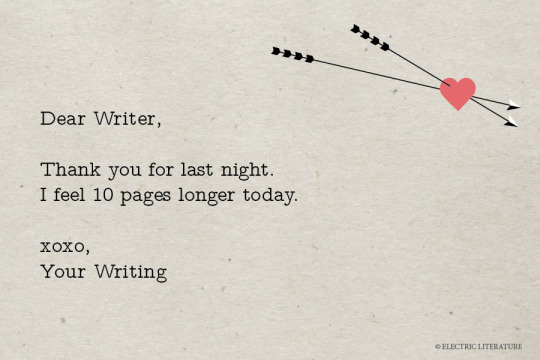


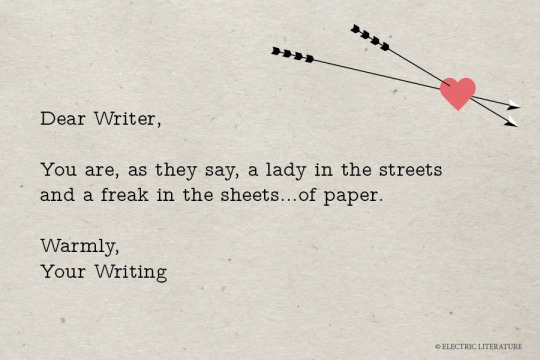


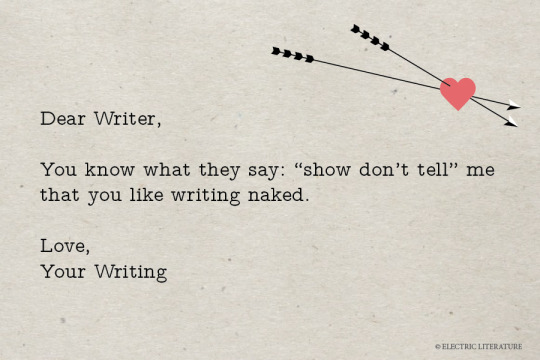


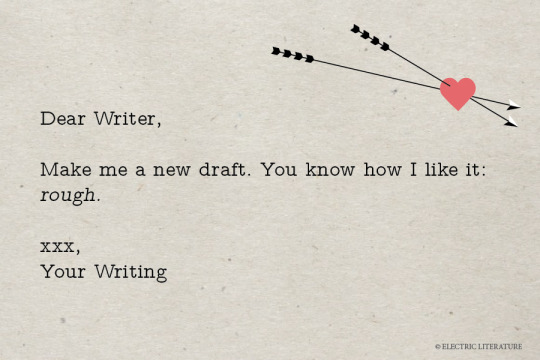
Love Letters From Your Writing
(via Electric Lit)
77K notes
·
View notes
Text
The Last Words Of 25 Famous Dead Writers
When you’ve dedicated your life to words, it’s important to go out eloquently.
Ernest Hemingway: “Goodnight my kitten.” Spoken to his wife before he killed himself.
Jane Austen: “I want nothing but death.” In response to her sister, Cassandra, who was asking her if she wanted anything.
J.M Barrie: “I can’t sleep.”
L. Frank Baum: “Now I can cross the shifting sands.”
Edgar Allan Poe: “Lord help my poor soul.”
Thomas Hobbes: “I am about to take my last voyage, a great leap into the dark,”
Alfred Jarry: “I am dying…please, bring me a toothpick.”
Hunter S. Thompson: “Relax — this won’t hurt.”
Henrik Ibsen: “On the contrary!”
Anton Chekhov: “I haven’t had champagne for a long time.”
Mark Twain: “Good bye. If we meet—” Spoken to his daughter Clara.
Louisa May Alcott: “Is it not meningitis?” Alcott did not have meningitis, though she believed it to be so. She died from mercury poison.
Jean Cocteau: “Since the day of my birth, my death began its walk. It is walking towards me, without hurrying.”
Washington Irving: “I have to set my pillows one more night, when will this end already?”
Leo Tolstoy: “But the peasants…how do the peasants die?”
Hans Christian Andersen: “Don’t ask me how I am! I understand nothing more.”
Charles Dickens: “On the ground!” He suffered a stroke outside his home and was asking to be laid on the ground.
H.G. Wells: “Go away! I’m all right.” He didn’t know he was dying.
Johann Wolfgang von Goethe: “More light.”
W.C. Fields: “Goddamn the whole fucking world and everyone in it except you, Carlotta!” “Carlotta” was Carlotta Monti, actress and his mistress.
Voltaire: “Now, now, my good man, this is no time for making enemies.” When asked by a priest to renounce Satan.
Dylan Thomas: “I’ve had 18 straight whiskies…I think that’s the record.”
George Bernard Shaw: “Dying is easy, comedy is hard.”
Henry David Thoreau: “Moose…Indian.”
James Joyce: “Does nobody understand?”
202K notes
·
View notes
Photo
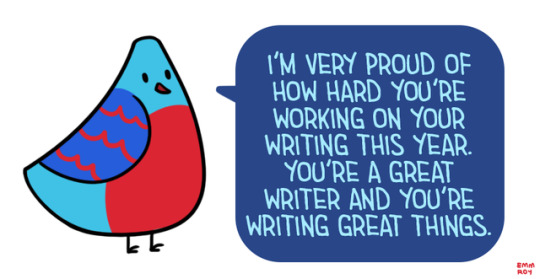
[Drawing of a blue and red bird with blue and red wings saying “I’m very proud of how hard you’re working on your writing this year. You’re a great writer and you’re writing great things” in light blue text on a dark blue speech bubble.]
8K notes
·
View notes
Photo

Limits of the Human Body by Soda Pop Avenue
Credit goes to SPA, but I wanted this here for a writer’s reference. This way we know exactly how far we can push our characters ;)
403K notes
·
View notes
Text
you know whats wayyyyy easier than writing? scrolling through tumblr for hours and hours and tangentially thinking about your WIPs but not Actually working on them
75K notes
·
View notes
Text
IT’S NOT ‘PEEKED’ MY INTEREST
OR ‘PEAKED’
BUT PIQUED
‘PIQUED MY INTEREST’
THIS HAS BEEN A CAPSLOCK PSA
686K notes
·
View notes
Text
Tips On How to Write Characters with Wings (For both fanfic writers and original content writers)

So I’ve been reading a lot of fics lately where people are either
A) Putting wings onto canon characters
B) Making OCs with wings
So I decided that, with the influx of people who are writing winged characters (and therefore the influx of errors that come with writing winged characters), I’d make a little thing to help you slap a pair of wings onto anyone!
This is also a bit personal, too, because the MC in my upcoming novel has wings!
1. Know that there are a lot of types of wings to choose from
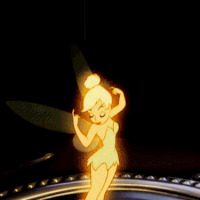
Part of being a writer is the desire to take something (whether it be a pre-existing work or an idea in your head) and make it into your own. So, instead of just going with the classic bird wings, why not spice it up a bit? If your character is an angel, you certainly don’t have to stick to the classic depictions of angel wings. Why not give them butterfly wings or dragonfly wings?
Here’s a small list of different types of wings to choose from:
Bat wings
Beetle wings
Bird wings
Butterfly/Moth wings
Dragonfly wings
Note that these wings are for animals who can fly. There are also animals who can “fly” that actually glide, such as sugar gliders and flying squirrels.
Yeah, so the options are pretty limited, but feel free to make up your own kinds of wings that aren’t necessarily based on a pre-existing creature’s wings!
2. Be familiar with the anatomy of your character’s wings and their limits

If your wings are completely unique, draw them out. A diagram or picture is key when it comes to things like description. I’m not gonna tell you what everything does and give you Animal Wing Anatomy 101, that’s for you to research. Know that there are different types of wings and that they have different uses, strengths, and weaknesses.
3. Never use the full extent of your research!

Surprise, surprise!
“But wait, Maddy!” you cry, writing utensil in hand and poised to stab me. “I thought we were supposed to were supposed to show our research!”
Well, you are. Technically that’s not wrong. But, readers don’t want to know ALL of it. Over-described wings are sometimes worse than under-described wings; what sucks more than not knowing what a character’s wings look like is having to look up wing anatomy in the middle of the chapter!
Only use the most basic of vocabulary when it comes to describing the parts of the wing. Most of the time, you just have to say “bat wing” or “feathery wing” and the readers get the basic idea. (Like seriously, do you think the readers know what a dactylopatagium brevis is????? It’s a part of skin on a bat’s wing btw)
4. Don’t bring your character’s wings up only when they’re needed!!!!
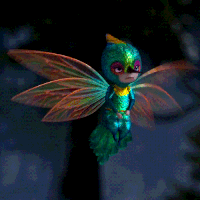
Unless your character’s wings can fade away when they’re not needed, wings are a 100% real, 24/7 thing! It’s bothersome when writers mention the wings in one chapter and then only bring them up when there’s a daring escape that needs to be performed! Most of the time, I forget that the characters even have wings at all!
There is also the fact that wings aren’t all pros and no cons. If they’re functional, they’re probably big, and if they’re muscular, they’re probably bulky. If your character is clumsy, they’ll probably knock things over constantly, and if they’re not clumsy, they’ll still knock things over constantly.
Your wings are two (or four, or five, or six quintillion) extra appendages; they’re a part of your character! You don’t have to spend every second reminding the readers that they’re there, but don’t go long stretches of time without even mentioning them.
5. Your character’s wings can be a good way to indicate their mood or to provide for that little bit of description that you think you make be lacking
Why wouldn’t you want to describe the wings? I mean, you don’t want to describe every minute detail over and over again, but it’ll boost your word count a lot more than you think. They can also be used to convey your character’s feelings without explicitly telling the reader! It’s like a new set of facial expressions!

See? You can tell he’s wary and ready to fight from the movement of his wings! Also he’s crouching next to a dead body but that’s not relevant right now
Here’s a list of wing language (?) that you can incorporate into your story that will not only increase your word count, but will also add to the sustenance of your story!
Nervous
Twitch
Flutter
Ripple
Fold tightly
Fidget
Flap
Angry
Flare
Bristle
Fluff up
Ripple
Beat
Raise up
Snap open
Happy
Flutter
Curl up
Ripple
Wave
Flap
During Battle
Bludgeon
Smack
Bat
Clout
Whack
Kick someone’s legs out from under them
Snap someones neck (only for muscular wings like bat and bird wings)
Problems that may come with having wings
Poke out from under blankets and let all of the cold air in
Stepped on
Get pins and needles from being folded for too long
Squashed on chairs/ in beds/ in crowded hallways
Vulnerable in battle
Molting (for bird wings)
Hope this helped!!!
43K notes
·
View notes
Photo


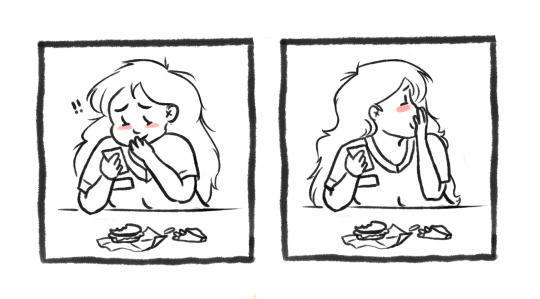
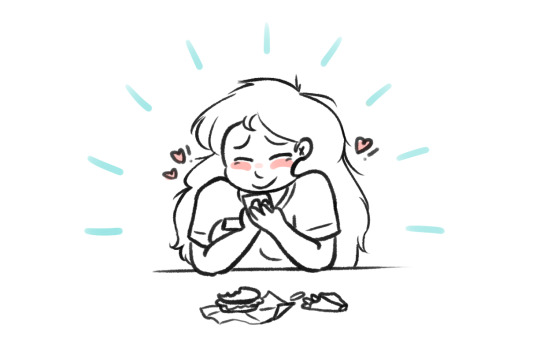
to everyone who’s ever said something kind about my work: you help me get through the day. thank you.
198K notes
·
View notes

